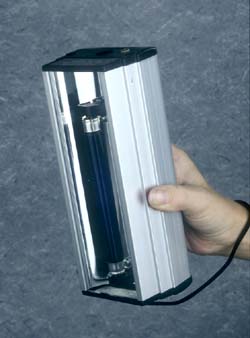Ultraviolet induced fluorescence:
Sources of ultraviolet radiation
The sources of ultraviolet radiation for inducing fluorescence are the same as those for the reflected ultraviolet technique, and the reader is referred to the 'Sources of ultraviolet radiation' section of the reflected ultraviolet article for details. Dermatologists use continuous high-pressure mercury vapour lamps fitted with Wood's filters for inspection, but electronic flash is always used for photography of patients. The relatively low emission of the hand-held Wood's lamp necessitates exposures that are too long for the living subject; alternatively one is tempted to place the lamp too close to patients with the attendant risk of burning them. It is however, very helpful for the photographer to have a continuous source of ultraviolet available in order to locate the area that is fluorescing, prior to recording with electronic flash. Some manufacturers build small hand lamps with ultraviolet emitting fluorescent tubes driven by batteries. These are most useful for locating areas of fluorescence in the clinical studio when working on location. Figure 5 shows an example of such a lamp. Continuous sources of ultraviolet such as mercury vapour discharge lamps are useful for the photography of fluorescence from static objects such as documents, minerals, gels and chromatograms. It is worth re-emphasising that care should be taken with these lamps, especially the low-pressure variety, in order to avoid damage to skin and eyes. It is imperative to use effective barrier spectacles when viewing with a continuous source, not only because of the danger of conjunctivitis, but also because the crystalline lens within the eye itself fluoresces, making it very difficult to see clearly.
 |
Figure 5 (left). A battery operated, portable hand lamp is invaluable for identifying where (and if) fluorescence is occurring prior to full photographic recording. |
|


![]() Home > Articles > Fluorescence Photography > Ultraviolet induced fluorescence: Sources of ultraviolet radiation
Home > Articles > Fluorescence Photography > Ultraviolet induced fluorescence: Sources of ultraviolet radiation